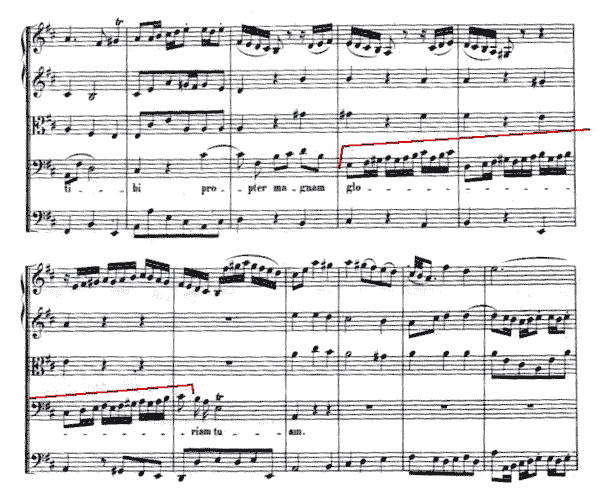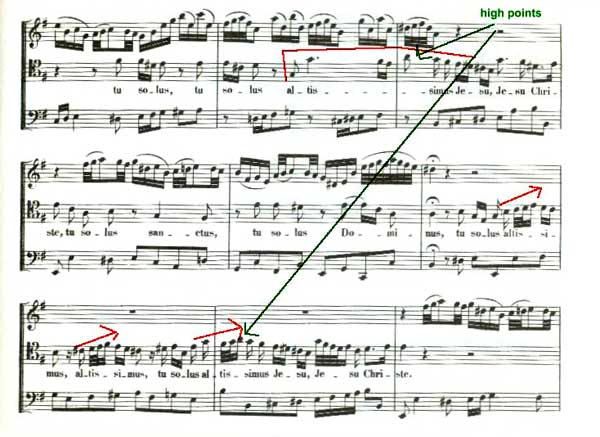Between 1737 and 1748 Bach wrote at least five Masses, four of which survive in their entirety. (The C Minor Mass exists only as a fragment.) These are known as the Missa brevis (plural is Missae brevis), meaning brief Masses or Lutheran Masses, in contrast to the Mass in B Minor, Bach’s only Latin work following the complete Catholic Mass structure. But none of these Masses gets much attention in either Bach scholarship or performances, suffering first from being in the shadow of the Mass in B Minor – called by Georg Nägeli one of the “greatest musical works of art of all times and all peoples” – and second by the fact that each of these four Masses are “parody” works. A parody work is one based on preexisting music. Parody Masses were common in the Renaissance, whereby a composer would create a new musical work out of old material. Normally, that “old material” was a chant or popular song, some musical element that would be recognizable to the choir and congregation. For two famous examples, see Josquin’s Missa pange lingua (based on the chant “Pange lingua”, still used today in the Catholic Church), or Machaut’s Missa l’homme armé (which is based on a popular song).
Bach’s Masses, however, are parodies of his own work. In modern times, we tend to think of the word “parody” in terms of comedy; but the original use of the word in music had no such connotations. In fact, parody was a common technique that was often a form of flattery – if your work proved to be the source of the parody,then your music had to be fairly well known, perhaps even well respected. In the present case, Bach’s Mass in G Major is largely based on his own earlier cantatas:
- The Kyrie is derived from Cantata 179
- the opening movement of the Gloria comes from Cantata 79
- the “Gratias agimus tibi” movement is derived from Cantata 138
- continuing in the Gloria, the movement “Domine Deus” also comes from Cantata 79
- “Quoniam tu solus sanctus” comes, like the Kyrie, from Cantata 179
- the final movement of the Gloria, “Cum Sancto Spiritu”, originates from Cantata 17
[For more information about the connections, see: Robin A. Leaver, “The mature vocal works and their theological and liturgical context,” Chapter 7 of The Cambridge Companion to Bach, p. 115.]
These four Masses differ form the big Mass in B Minor in that they do not include all of the same movements. For this reason, I personally prefer to refer to these as Bach’s “Lutheran Masses” rather than use the term “missa brevis”. The term “missa brevis” means short Mass, though it does not indicate the manner in which the Mass is shortened – is it simply by writing shorter movements, but including all of the traditional Ordinaries of the Catholic Mass (as you observe in all of Mozart’s works using the title “missa brevis”)? Or is it an an indication of actually excluding movements (as in Bach’s examples)? For me, the fact that Bach sets only the Kyrie and Gloria, and not the movements associated with the Liturgy of the Eucharist in the Catholic Church, is what separates his setting from Catholic musical and liturgical tradition, and is the reason why I prefer the term “Lutheran Mass” to refer to these four works.
Robin Leaver writes that these four Lutheran Masses all use a “symmetrical, five-movement Gloria in which a central movement (in BWV 236 a duet) is framed by two arias and two choruses.”
The Kyrie of Mass in G Major begins with a lovely, meditative fugue – a real “throw-back” movement, drawing on the contrapuntal tradition of the Renaissance motet and Mass, relying entirely on the voices to drive the music. There is a continuo part written, but one can easily see that this is not an entirely independent part; rather, the continuo often doubles the bass voices of the choir, and throughout provides harmonic support for the singers. It does not, however, take part in the unveiling of the fugue.
This wondrous fugue has so many wonderful points to highlight; I cannot possibly cover them all here. Rather, let me select a few particularly notable items.
- I love how Bach inflects a new key – C major, the subdominant – so close to the start of the movement, simply by lowering the continuo from F-sharp to F-natural in the third measure. It doesn’t last, but it’s a lovely effect which keeps us tonally alert for more tonal wanderings and ambiguities.
- The fugue begins with a full fugal exposition on the words “Kyrie eleison,” introducing the text and subject beginning in the bass voices, and moving up in order through tenor, soprano, and then alto.
- The tenors are the second voice to enter, but rather than sing the subject in a new key (D major would be expected), they instead remain in G major initially – perhaps because Bach already hinted at a new key area (see above) – and inverts the subject (turns it upside down). This is something students of counterpoint and the fugue will know is a common device, though extremely rare in an exposition.
- When the altos enter, they take the tenor’s inverted subject as their own. By now, the texture is so full of chromatic twists and turns that it is difficult to get the “feel” of one primary key area for any length of time.
- After the bass voices drop out of the texture for a few measures, they re-enter in m. 31 with an abridged version of the tune previously (m. 1) found in the continuo – that distinctive line with the F-natural in it.
- After a strong cadence back in G major to close out the “Kyrie eleison” text, the second portion of text, “Christe eleison”, introduces a new fugal idea (m. 37). This time, the subject is introduced a cappella, and the brief subject moves from soprano, downward to alto, tenor, and bass (doubled by continuo), respectively.
- This new fugue subject takes the descending chromatic idea from the first subject’s continuo line, and puts it into a more prominent position, as well as extending the idea.
- Notice, too, how short the setting of the “Christe eleison” text is, compared to the “Kyrie eleison” that opened this movement. Beginning in m. 44 (in the alto), the “kyrie” text returns; hereafter, Bach intermingles “Kyrie eleison” and “Christe eleison”. (For those of you who are not familiar with the “Kyrie eleison” text of the Catholic Ordinary, the return of “Kyrie eleison” is expected – but not a second return of “Christe eleison”.) With the combination of these two texts, Bach also combines the two fugue subjects to create an even more complicated texture than we have seen previously in this work.
The “Gloria” follows. As is typical in the musical settings of this Ordinary, the long text is subdivided into several smaller movements. A summary of the movements are shown in the chart below. (Remember that the first movement of the Mass in G Major is the “Kyrie eleison”; the “Gloria” encompasses movements 2-6.)
| Movt. | Text | Scoring | Key | Meter, tempo | Special Notes |
| 2 | Gloria in excelsis Deo. Et in terra pax hominibus bonae voluntatis. Laudamus te. Benedicimus te. Adoramus te. Glorificamus te. | 2 oboes, strings, continuo, SATB choir | G Major | 2/2, quick | Begins with SA choral voices in parallel thirds, accompanied by orchestra; followed by long (20 ms.) orchestral interlude |
| 3 | Gratias agimus tibi propter magnam gloriam tuam. Domine Deus, rex coelestis, Deus Pater omnipotens. Domine Fili unigenite Jesu Christe. | Strings, continuo, bass solo | D Major | 3/4, moderate | A minuet (Little and Jenne); first violins of the orchestra have elaborate writing that imitates an obbligato solo line; continuo part also unusually elaborate |
| 4 | Domine Deus, agnus Dei, [Filius Patris,] qui tollis peccata mundi, miserere nobis! Suscipe deprecationem nostrum. Qui sedes addextram Patris | Violin I, II; continuo; soprano and alto solo | A minor | 2/2, moderate | Parallel thirds in voices reminiscent of opening of the Gloria; violins in unison throughout |
| 5 | Quoniam tu solussanctus, tu solus altissimus Jesu Christe. | Oboe solo, continuo, tenor solo | E minor | 4/4, adagio | Trio sonata texture; solo voice used for text “you alone[solus] are holy, you alone are most high” |
| 6 | Cum sancto Spiritu in gloria Dei Patris, Amen. | 2 oboes, strings, continuo, SATB choir | G major | 4/4 and slow initially, (first 6 measures); then 3/4 and spirited | “Spirited tempo” reflects the Holy Spirit; overall character reflects “in gloria” – joyous and lively |
The table above provides a synopsis of the movements, but cannot point to all the highlights – nor, truly, can I, but I will attempt to direct the reader to a few choice moments.
The third movement is a minuet, a stately movement with a long orchestral introduction. Bach appropriately sets a long melisma on “gloriam tuam” (your glory) each time this text appears – as you can see in the excerpt below. This aria is da capo-like, because the opening music returns, though with a different text. Although the duplication of music does not continue throughout the rest of the piece, there is enough motivic similarity for it to feel like a da capo aria without Bach actually writing one.

The fourth movement, “Domine Deus, rex coelestis”, uses a four-part texture: two solo voices (soprano and alto), orchestral violins in unison, and continuo. The continuo introduces the vocal melody by itself to start the movement; this is then picked up by the soloists, who sing in parallel thirds – reminding us of the parallel thirds in the choral sopranos and altos which began the second movement. The continuo plays a key role in supporting the texture as well as is introducing important motivic ideas throughout, as you can see in the example below. Here, an ascending arpeggio begins in the continuo, and then is echoed in the violins. This is the primary instrumental motive throughout the movement – and we can find a connection between this idea and the rising arpeggio in the solo bass voice of the preceding movement.
The fifth movement, an aria for tenor with oboe solo, uses the shortest text. It is a highly ornamental movement for both soloists – as well as for the continuo, which is easy to overlook in the rest of the texture. Bach creates a lovely example of word painting near the end, leaping to a musical high point on “altissimus” (most high), and descending from there; shortly thereafter, he repeats the same text, this time starting in a lower register and working the soloist upward, to the “most high” point. As if to reinforce the idea not just of “most high”, but “you alone”, this second move towards the high point occurs in the solo tenor alone – without the assistance of the solo oboe.











































